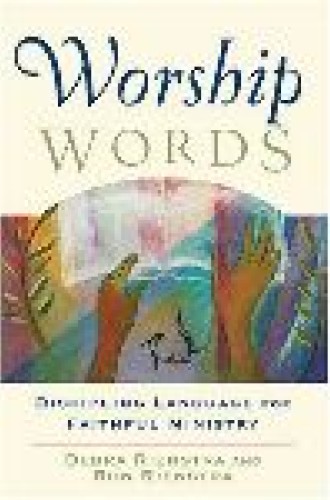Words for worship
Mark Twain once said, “The difference between the almost right word and the right word is really a large matter—’tis the difference between the lightning-bug and the lightning.” By this standard, one might conclude that much of Christian worship in the United States is infested, suffering from liturgy that is crawling with almost right words. That’s the assumption at the heart of two new books on language and liturgy. What Language Shall I Borrow? The Bible and Christian Worship and Worship Words: Discipling Language for Faithful Ministry both address the problems and possibilities of liturgical language. Yet while all the authors are committed to getting the words right, the books offer very different approaches to crafting meaningful liturgy.
What Language Shall I Borrow? is presented as a general defense of biblical language in worship. Ronald Byars takes a sola scriptura approach, arguing that the best words for worshiping God are found in the Bible. He sets out to prove his thesis with a painstaking analysis of the Service for the Lord’s Day found in the 1993 Presbyterian Book of Common Worship.
Byars’s book is organized around the four movements of the classic ordo: Gathering, the Word, the Eucharist and Sending. In each chapter, Byars explores the biblical roots and theological claims of the BCW liturgy, in some places taking the text line by line. He demonstrates how the biblical language of worship can function as a means of liturgical cate chesis, not merely expressing faith, but shaping the faith of a community. Each chapter concludes with a “Bible En counter,” which contains a list of related scripture passages for further study.
This volume has some beautiful moments, as when Byars, in the midst of exegeting the Prayer for Illumination, notes that we can never fully know God: “God does not seem inclined to reveal to us mysteries when those revelations serve no purpose but to satisfy our curiosity.” He also offers one of the clearest theological rationales for why it is essential that we pass the peace in worship. But beyond the occasional gem, this book has limited appeal. Although the preface suggests that Byars’s aim is ecumenical, he is clearly a Presbyterian writing for Presbyterians. Without a working knowledge of the Book of Common Worship, most readers will find his analysis slow going, especially when he gets microscopic in his analysis of the liturgy: “Let us now examine the Prayers of the People (Option C).” Furthermore, much of the biblical scholarship is elementary, suggesting that Byars had laypeople in mind when he wrote it.
But the main problem with What Language Shall I Borrow? is that Byars doesn’t make the case for biblical language in worship: he assumes it. If you agree with Byars that “the communal speech that truly honors God is, in fact, biblical language,” then Byars has a word for you. But if you, like so many others, find biblical language too loaded, too constraining or too formal, Byars will not persuade you otherwise.
In sharp contrast to Byars’s in-depth study of one liturgical tradition, Debra and Ron Rienstra’s book takes a much broader approach to liturgical language. Their thesis is simple: words matter, so pay attention. Designed as a workbook for pastors and worship leaders, Worship Words offers a wide variety of techniques for analyzing, exploring and developing liturgical language. By “doing words better,” the Rienstras contend, we can create worship experiences that are authentic as well as excellent, experiences that draw people nearer to God and prepare the Christian community for service.
Such a lofty goal demands a multifaceted approach, and the Rienstras don’t disappoint. Worship Words covers a rich and expansive set of topics—almost too expansive given the limited space. First, they examine the four dimensions of worship language: aesthetic, expressive, instructive and memorial. Then they move to a discussion of the dialogic nature of worship, asking the question “Who is speaking to whom?” This brilliant bit of analysis is followed by chapters on chatter (please don’t) and repetition (please do). Two of my favorite topics are the use (and abuse) of metaphor in worship and the necessity of expanding our repertoire when it comes to naming God. Each chapter concludes with a set of exercises designed to allow worship leaders to put theory into practice through observation, discussion and the creation of liturgy. I found myself marking pages for later use with our worship committee and copying word lists to enrich my own liturgical vocabulary.
The second half of the book is not as strong as the first. The four chapters on types of worship (traditional, contemporary, global and lamenting) reflect too much of the Rienstras’ own biases and preferences, revealing more about the church they attend than the church universal. The final chapter, titled “The Embedded Word: Putting It All Together,” is too short to be of real use, and the reader might be better served by rereading Tom Long’s classic Beyond the Worship Wars, which the Rienstras quote at some length. Moreover, the appendices (with the exception of “Practical Advice for All Occasions”) seem to be part of another book; they read like an introductory textbook on planning worship. But these are small issues. Worship Words is a highly readable and useful guide to enriching, expanding and sharpening the language of worship for the benefit of the Christian community.
I did wonder why none of these authors mentions theology. Byars writes from a distinctly Presbyterian theological perspective, so perhaps he assumes that all worship leaders have as robust and coherent a theology as he does; if so, it is an unwarranted assumption, to be sure. Given the breadth of the Rienstras’ approach, I expected them to at least mention the topic. A text box in chapter 9 listing the “Characteristics of Good Worship Wordsmiths” includes everything from mastery of syntax and grammar to personal humility to solid biblical knowledge, but not one word about theological competence or engagement. This strikes me as a glaring omission, for worship is ultimately an extension and expression of communal theology. Simply put, there’s no point in searching for the right words or crafting authentic liturgy if you don’t know why you feel moved to speak in the first place. Cato the Elder said it best: “Rem tene, verba sequentur”: Grasp the subject; the words will follow.






